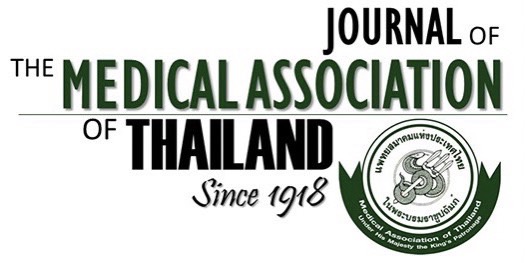Urinary Risk Factors for Recurrent Calcium Stone Formation in Thai Stone Formers
Wasana Stitchantrakul MSc*, Wachira Kochakarn MD**, Chatuporn Ruangraksa BSc*, Somnuek Domrongkitchaiporn MD***
Affiliation : * Research Center, Ramathibodi Hospital, Mahidol University **Department of Urology, Ramathibodi Hospital, Mahidol University *** Department of Medicine, Ramathibodi Hospital, Mahidol University
Objective : To survey the urinary risk factors associated with recurrent calcium stone and the contribution of
renal tubular acidosis to the prevalence of recurrent calcium stone formation in Thai recurrent stone formers.
Materials and Methods : There were 86 consecutive recurrent calcium stone formers. Three-day dietary record,
serum biochemical parameters, first morning urine pH, and two 24-hour urine collections were obtained from
each subject. Urinary risk factors for calcium stone formation were determined from the average of the 2-day
urine collection. Normal controls were 34 subjects matched for aged, sex, and weight, and without a history of
renal stone formation.
Results : Seven patients (8.1%) were diagnosed as incomplete renal tubular acidosis (iRTA). Among the 79
idiopathic calcium stone formers (ISF), 69.6%, 15.2%, 10.1%, 7.2% and 1.3% of patients were hypocitraturia,
hypercalciuria, low urinary volume, hyperuricosuria and hyperoxaluria, respectively. The common combina-
tions of risk factors were hypocitraturia plus low urine output (8.9%) or plus hypercalciuria (7.6%). There
were significant differences between ISF and normal controls in urinary oxalate excretion (0.16 + 0.01 vs 0.12
+ 0.01, p < 0.05), urinary calcium/citrate ratio (4.49 + 0.50 vs 2.83 + 0.34, p < 0.01) and ion activity product
for calcium oxalate stone (0.46 + 0.03 vs 0.33 + 0.03, p < 0.05). Urinary citrate in ISF varied directly with net
alkaline absorption (r = 0.34, p < 0.005) and urinary potassium (r = 0.54, p < 0.001). There were significant
correlations between urinary calcium excretion and both sodium excretion (r = 0.42, p < 0.001) and urea
excretion (r = 0.41, p < 0.001) in ISF. There were seven (8.1%) with incomplete renal tubular acidosis.
Patients with iRTA tended to have less urinary citrate and higher calcium/citrate ratio than did ISF, but
hypercalciuria was uncommon.
Conclusions : Hypocitraturia was the most common urinary risk factor found in Thai recurrent idiopathic
calcium stone formers followed by hypercalciuria and low urinary volume. Almost one-fourth of the stone
formers had multiple risk factors. Hypocitraturia might result from low potassium and low alkaline intake.
iRTA was common among recurrent calcium stone formers. Determination of morning urine pH should be a
part of the investigations for urinary risk factors to avoid overlooking the diagnosis of iRTA.
Keywords : Urolithiasis, Renal stone, Hypocitraturia, Hypercalciuria, Hyperoxaluria, Hyperuricosuria



